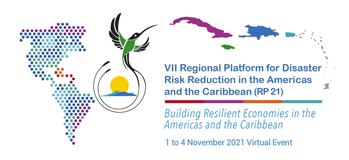St Vincent and Grenadines shows benefits of disaster planning
The Caribbean island state of St Vincent and Grenadines quickly evacuated over 20,000 people after the La Sufrière volcano erupted in April 2021, showing the benefits of good planning and preparation in a country where hazards are commonplace.
“We have been living with risk for a long time” said Michelle Forbes, Director, National Emergency Management Organisation (NEMO). The volcano last erupted in 1979. Most of those evacuated were moved into private homes, but several thousand needed to go into emergency shelter. “We zeroed in on vulnerable populations, prioritizing women and children under five,” she told a conference on disaster risk reduction (DRR) in the Americas and the Caribbean.
Disasters are a major cause of displacement of people around the world, with some 30 million being forced from their homes in 2020 by earthquakes, hurricanes, floods and other disasters. Latin America and the Caribbean are particularly prone to such hazards. Displacement is a driver and a consequence of disaster risk, generating humanitarian and human rights issues both within countries and internationally when people are forced to flee to safety across borders.
The Vll Regional Conference on Disaster Risk Reduction in the Americas and the Caribbean, which is being hosted by Jamaica 1-4 November, is examining the region’s implementation of the international blueprint on disaster risk reduction, the Sendai Framework, which identifies displacement as a critical issue.
Chile has been a regional leader in integrating displacement into national policy on disaster risk reduction. But it faced challenges in doing so, Luis Doñas, Foreign Affairs Liaison Officer, National Emergency Office of the Ministry of Interior and Public Security (ONEMI), told a conference session. These included lack of accurate information on displacement and routes used. Generating this information requires mechanisms for international cooperation on the movement of people, he said. He also stressed the need for close coordination between national and local administrations. The integration process in Chile, however, was aided by a growing awareness within civil society of the issues generated by displacement, he added.
Another issue raised at the session, whose theme was integrating disaster displacement into DRR strategies, policies, plans and legal frameworks, was the question of what services developing countries can offer to the displaced.
“We have to determine what is realistic,” Michelle Forbes said, adding that people are not prepared to be displaced for a long time. “We don’t have any legislation on displacement.”
The importance of laws on displacement provoked by climate change and disasters was highlighted by Sophie Teyssier, Coordinator for the Americas, Disaster Law and Legislative Advocacy, International Federation of Red Cross and Red Crescent Societies (IFRC).
The IFRC has drawn up a benchmark check list of recommendations for legislation on disaster displacement, which often stems from slow-onset hazards like drought that take
years to develop. These include protection and assistance for displaced people that cover their basic needs. Most displacement occurs within a country. But the identification, entry, stay and entitlements of cross-border disaster-displaced persons should be consistent with international huma rights law.
“Disaster law is key because it helps to clarify responsibilities. It also helps to set coordination mechanisms across all sectors from national to local level,” Sophie Teyssier said.
Liza Mariana Hernández-Betancourth, Regional Lead for Americas and the Caribbean, Global Network of Civil Society Organizations for Disaster Reduction (GNDR), said the organization is active in most countries in the region. “Countries are trying to take in these (displaced) people. But the number looking for secure place is exceeding capacity,” she said.


